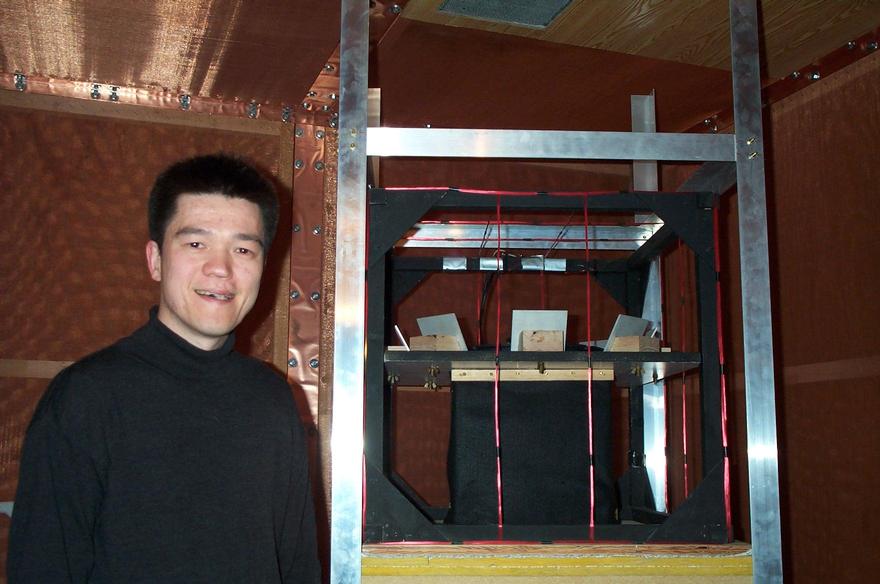| How can one test whether magnetoreception is indeed based
on the radical pair mechanism?
Tests for Light Dependence
There are a number of tests that are derived from the necessary conditions
of the radical pair mechanism. For example, if a radical pair is created
through a light induced electron transfer, then the magnetic compass will
be light dependent. Behavioral tests show that birds cannot orient under
red and yellow ambient light conditions, while they can orient under monochromatic
blue and green light. Newts show 90 degree shifts in magnetic orientation
under long wavelength light. The light sensitive organ has been localized
to be the right eye in birds and the pineal gland in newts. However, these
light dependent effects could be due to an indirect influence of light
on the magnetic compass and thus offer no conclusive evidence for the involvement
of radical pairs in magnetoreception.
Animal Response Detected Magnetic Resonance
The sensitivity of radical pair reactions to the geomagnetic field is
based on the influence of static magnetic fields on the spin states of
the radical pair. However, there is a different way to influence spin states
of a radical pair, namely through resonant electromagnetic radiation, i.e.
through electromagnetic fields that provide precisely the energy that is
needed to bridge the energy gap between two different spin states. The
external static magnetic field as well as the static magnetic fields of
nuclear spins in the radical pair system will induce an energetic splitting
of spin states in the region of about 0.5 to 20 MHz. Therefore, weak electromagnetic
fields at appropriate frequencies in the radio frequency
(RF) range should disrupt or change magnetic orientation behavior if
the magnetic compass were
based on radical pair reactions.
In essence, a magnetic resonance experiment can provide a test for the
radical pair hypothesis. However, the two main differences to standard
magnetic resonance tests are that we detect the resonance very indirectly,
namely through the magnetic orientation response of an animal in the presence
of various RF fields. Secondly, the static field needs to be either the
geomagnetic field or a field of similar strength, so that animals show
their natural magnetic orientation response. The static field is therefore
much weaker than the fields used in standard magnetic resonance techniques.
Our Research Program
In order to identify for which frequency and amplitude a RF field will
disturb a radical-pair based magnetic compass, a quantitative understanding
of oscillating and static magnetic field effects is necessary which requires
solving the stochastic Liouville equation for an appropriate spin Hamiltonian.
The physics of weak magnetic field effects is not yet fully understood
because former research focussed mostly on effects of large fields, such
as are employed in standard magnetic resonance techniques.
 Using
the outcome of these calculations as input, the effect of weak RF magnetic
fields on magnetic orientation behavior of various animals will be investigated
at predetermined frequencies. We collaborate with several groups that have
developed behavioral assays to study magnetic compass orientation. With
the John Phillips lab, Virginia Tech, we investigate the effects of RF fields on newts
(Notophthalmus viridescens) and fruit flies (Drosophila melanogaster, see
picture for the fruit fly testing arena). With the Wiltschko lab, Frankfurt, Germany, we investigate
RF effects on migratory birds. Using
the outcome of these calculations as input, the effect of weak RF magnetic
fields on magnetic orientation behavior of various animals will be investigated
at predetermined frequencies. We collaborate with several groups that have
developed behavioral assays to study magnetic compass orientation. With
the John Phillips lab, Virginia Tech, we investigate the effects of RF fields on newts
(Notophthalmus viridescens) and fruit flies (Drosophila melanogaster, see
picture for the fruit fly testing arena). With the Wiltschko lab, Frankfurt, Germany, we investigate
RF effects on migratory birds.
Effects of RF fields on orientation behavior at the frequencies predicted
and an
absence of RF effects at other frequencies would provide compelling
evidence that magnetic
sensors are based on radical-pair processes and thus solve a fundamental
problem of sensory
biology.
|